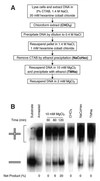A method for preparing genomic DNA that restrains branch migration of Holliday junctions
- PMID: 10606674
- PMCID: PMC102538
- DOI: 10.1093/nar/28.2.e6
A method for preparing genomic DNA that restrains branch migration of Holliday junctions
Abstract
The Holliday junction is a central intermediate in genetic recombination. This four-stranded DNA structure is capable of spontaneous branch migration, and is lost during standard DNA extraction protocols. In order to isolate and characterize recombination intermediates that contain Holliday junctions, we have developed a rapid protocol that restrains branch migration of four-way DNA junctions. The cationic detergent hex-adecyltrimethylammonium bromide is used to lyse cells and precipitate DNA. Manipulations are performed in the presence of the cations hexamine cobalt(III) or magnesium, which stabilize Holliday junctions in a stacked-X configuration that branch migrates very slowly. This protocol was evaluated using a sensitive assay for spontaneous branch migration, and was shown to preserve both artificial Holliday junctions and meiotic recombination intermediates containing four-way junctions.
Figures




References
MeSH terms
Substances
LinkOut - more resources
Full Text Sources
Other Literature Sources
Molecular Biology Databases

